Matzke News – February 2014
Here’s our latest newsletter. Thanks for your interest, prayers and support!
Click on the link to open the PDF file.
Here’s our latest newsletter. Thanks for your interest, prayers and support!
Click on the link to open the PDF file.
A couple of weeks ago I flipped on the radio in the car on my way home. I was surprised to hear an advertisement for a new radio program that would be starting in a few weeks on the topic of “Languages of the Solomon Islands”.
I went down to the radio station the next week to find out about the program and find out if there were ways that we could help provide resource people and information. My friend Karen and I sat down with Moddie, the host of the radio program. Moddie explained that it has been on her heart to start a program on languages, but she was happy to have some help on ideas for program topics. Karen has an MA in linguistics and loves to talk about languages – especially from the Solomon Islands.
Moddie asked us to come back to the station today so she could interview Karen for the radio show. Karen recorded two programs today and they will start airing this Thursday all over the country.
What a wonderful opportunity to be able to share about languages around the Solomons and share about Bible translation work.
One of our translation team members out in the village came down with malaria last week. She began treatment and soon was feeling better. But along with the malaria came a case of cellulitis and blisters covered her legs.
The family takes a supply of medicines with them, and after consulting with a doctor by email (sent via their two way radio), she began a course of anti-biotics. They only had enough drugs to get them through Thursday night, so more drugs were purchased and we began looking for a ship heading in their direction that could carry the package out to them.
A local dive company often takes divers to the beautiful islands where this family lives. A phone call to the company office confirmed their plans to go to islands and their willingness to take the package. The ship was due to leave Thursday afternoon.
Yesterday I packed the drugs, a few veggies and their mail and took it to the dive office. Later the woman called to say that the dive shipped planned on getting to the Russells on Sunday afternoon. I thanked them, but my heart sank as I thought about Joanna’s blisters and the much needed drugs that would keep the healing process going. What would happen if she didn’t have the antibiotics for two days?
This morning the office manager from the dive company called to say that the ship’s captain had called to say that they had changed plans and were now going to be in the Russell Islands THIS morning (Friday). The captain said that if the family didn’t get word in time, he would leave the meds in the hands of the village chief and they could pick up the package from him later.
Wow. The God who calms the seas can also change the direction of a ship full of tourists out on a dive tour. I guess I shouldn’t really be surprised, but oh, my heart is happy this morning.
After spending the morning in the office answering emails, at lunch time we headed to town to buy fresh produce for one of our village teams. This family has not been getting many fruits and veggies from local sources.
Armed with a wish list that the family had emailed in, we headed into the market.
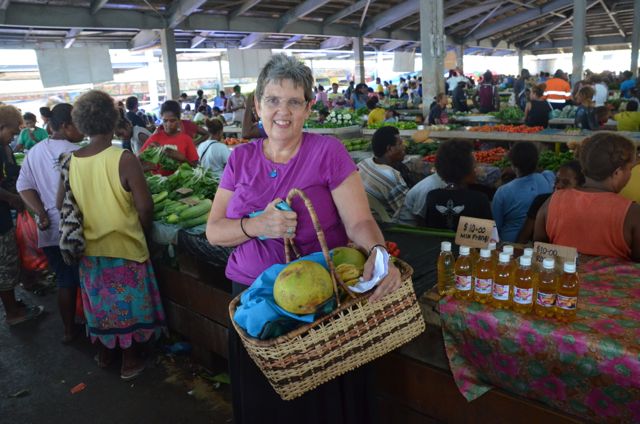 We stopped in a store for some empty boxes, packing tape and a marking pen. We packed up the produce in old newspapers and packed them in a box with a block of ice.
We stopped in a store for some empty boxes, packing tape and a marking pen. We packed up the produce in old newspapers and packed them in a box with a block of ice.
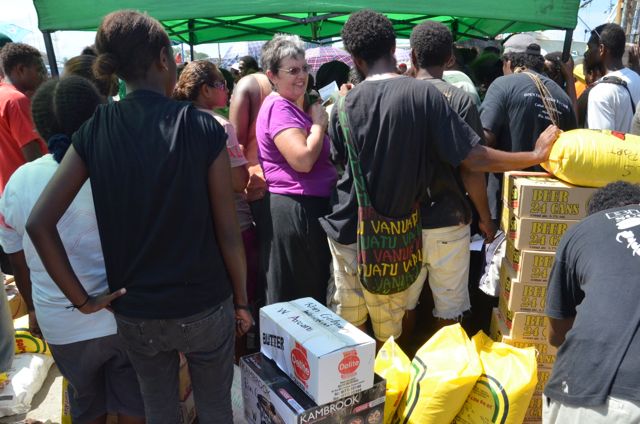 We headed to the wharf where we found the ship that was heading out to the village where the Gebauers live. Ship personnel were on the wharf selling tickets and collecting money for shipping cargo. There was a big crowd around the table and I wondered how long it was going to take to get to table to pay for the cargo.
We headed to the wharf where we found the ship that was heading out to the village where the Gebauers live. Ship personnel were on the wharf selling tickets and collecting money for shipping cargo. There was a big crowd around the table and I wondered how long it was going to take to get to table to pay for the cargo.
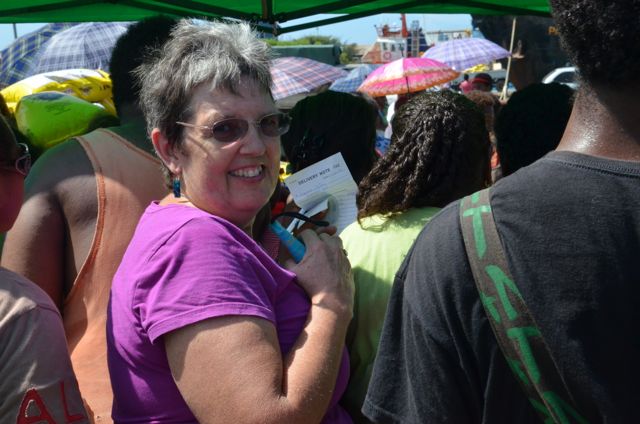
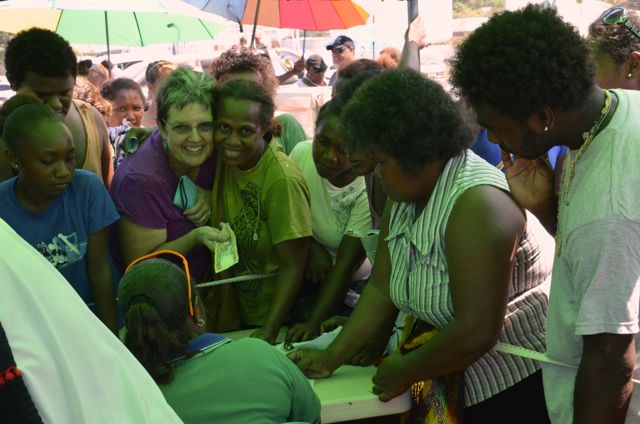 Luckily, one of the women pulled me to the table. Soon some of the other people were insisting that they take care of the boxes we brought. I was able to pay the fee (about $6 USD) and TIm passed the boxes to me and we were soon on our way.
Luckily, one of the women pulled me to the table. Soon some of the other people were insisting that they take care of the boxes we brought. I was able to pay the fee (about $6 USD) and TIm passed the boxes to me and we were soon on our way.
Sometime tomorrow the boxes should arrive in the village and Gebauers will have their produce.
Our latest newsletter is ready! You can download the letter here: Matzke Letter – Oct. 13
or read it here online:
Sunday 13 October
On to Sa’a village.
The only way to get from Afio to Sa’a is by ship or canoe. There is a road, but the bridge just past Afio washed out several years ago. So we load ourselves and our luggage into a canoe.
Solomon Islanders have been carving and paddling wooden canoes for centuries. And these canoes are still quite common. But for distance travel, everyone uses a more modern ‘canoe’. Fourteen to eighteen feet long and four to five feet wide, most canoes are made of fiberglass, have several bench seats and a covered front. They are powered by a 25 – 40 hp outboard motor and are absolutely essential for travel in this nation of islands.
The sea is actually fairly rough today; a bit of chop and rather large swells. The sea was smiling, according to a local saying (when you smile people can see your white teeth, think whitecaps).
The driver has to carefully adjust our speed as the canoe rides smoothly up a swell, nose in the air at the peak, and then slams down into the trough, ready to ride up the next swell. I’m glad my computer is not in the front. It wouldn’t like that pounding.
Our first port of call is Liwe (lee-way) Village. Liwe school is one of our pilot schools and we stop in to collect one of their teachers for the workshop. Turns out the Preparatory teacher cannot come because she has a young baby, so we wait while another teacher is found to take her place. We also find out that the Head Teacher, who should also attend, is at an ordination service at Waehi (why-hee) Village, across the bay. So we’re off to Waehi.
We reach Waehi in the pouring rain. I am very glad for my rain jacket and pants, but am still feeling a bit damp. We wait in a “rest house” for a while for the rain to slack off and for several more teachers. Someone shows up with a parcel of pudding- so we have a snack while waiting. When everyone is ready, and it is obvious that the rain is not going to stop, we head back to the canoe.
As we navigate around the next major point along the coast, it’s obvious that the conditions are a bit rough for our canoe – now with 10 passengers and our luggage. As we approach Sa’a village, there is some discussion (in the local language) as to whether or not to attempt to land. The small passage is a bit rough and would require carefully timing the waves, making a run for the shore, immediately jumping out as the canoe beaches and then quickly swinging the boat around so that the prow faces the incoming waves. A mis-timing of any of those actions could result in a wave swamping the boat, or even capsizing it. In the end, the decision is made to by-pass Sa’a and put ashore at Olosu’u, where there is a protected bay.
So now we are about 40 minutes walk past Sa’a, with all of our luggage. And to make things more interesting, the recent rains have flooded the road to ankle deep in places. Fortunately for us, there is a truck available that can give us a ride.
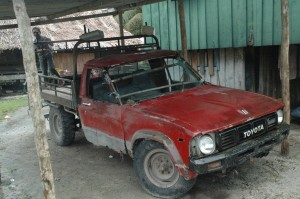 After about an hour’s wait, the truck finally arrives – though calling it a ‘truck’ is perhaps a bit generous. It’s a small Toyota pickup that has definitely seen better days. It lists sideways as it crawls down the road. The frame surrounding the windshield has rusted away and it’s seal is long gone. The frame is actually reinforced by some small wooden boards tied on with string. The windshield is basically just propped into place, leaving a 2 inch gap between it’s top and the pickup cab. The ground is visible through several holes in the floorboards, and the steering column has no cover on it. And of course, the body is rusted through in any number of places.
After about an hour’s wait, the truck finally arrives – though calling it a ‘truck’ is perhaps a bit generous. It’s a small Toyota pickup that has definitely seen better days. It lists sideways as it crawls down the road. The frame surrounding the windshield has rusted away and it’s seal is long gone. The frame is actually reinforced by some small wooden boards tied on with string. The windshield is basically just propped into place, leaving a 2 inch gap between it’s top and the pickup cab. The ground is visible through several holes in the floorboards, and the steering column has no cover on it. And of course, the body is rusted through in any number of places.
But the pickup still runs. So we pile our luggage and ourselves in the back and set off down the road. We don’t break any speed records, but is sure beats walking. And it doesn’t take all that long for us to arrive in Sa’a village.
In fine weather, with a lighly loaded canoe and a 40 hp engine, the trip from Afio to Sa’a takes a bit over an hour. Our journey took us six. But that’s the way it is.
I’m afraid I left you all hanging with my last blog post. So let me continue the journey with you.
Saturday 12 October
Afio – government substation for the southern region of Malaita province, nestled at the southern mouth of the passage between small Malaita and the main island. The Phoenix turns up the passage at this point, by-passing the eastern side of the island and Sa’a village. So we disembark at Afio to meet up with Richard, the Chief Education Officer for Malaita Southern Region, and get a canoe to Sa’a. Richard has to attend a funeral today, so we are here until Sunday morning.
There’s not much to Afio; a few government buildings, a disused market hall, and a couple of guest houses are tucked in-between the shoreline and a steep cliff. Up the hill a bit is a small hospital and a few houses for its staff. Further up are a few more houses for the substation workers, and a mobile phone tower.
The guest house has screens on the windows, but nobody has informed the mosquitos of this. So I’m glad I brought my mosquito net. There is no power grid. The guest house has a small solar system and the owners also fire up a small generator occasionally when there is no town water pressure or to run the lights when it’s been cloudy.
I manage to make a few calls back to Martha in Honiara, and send a few texts back and forth. But coverage is very spotty due to the steep cliff, and I have trouble maintaining a connection even when the signal is strong.
Yes, the modern conveniences are coming, but it’s still a bit “hit or miss”.
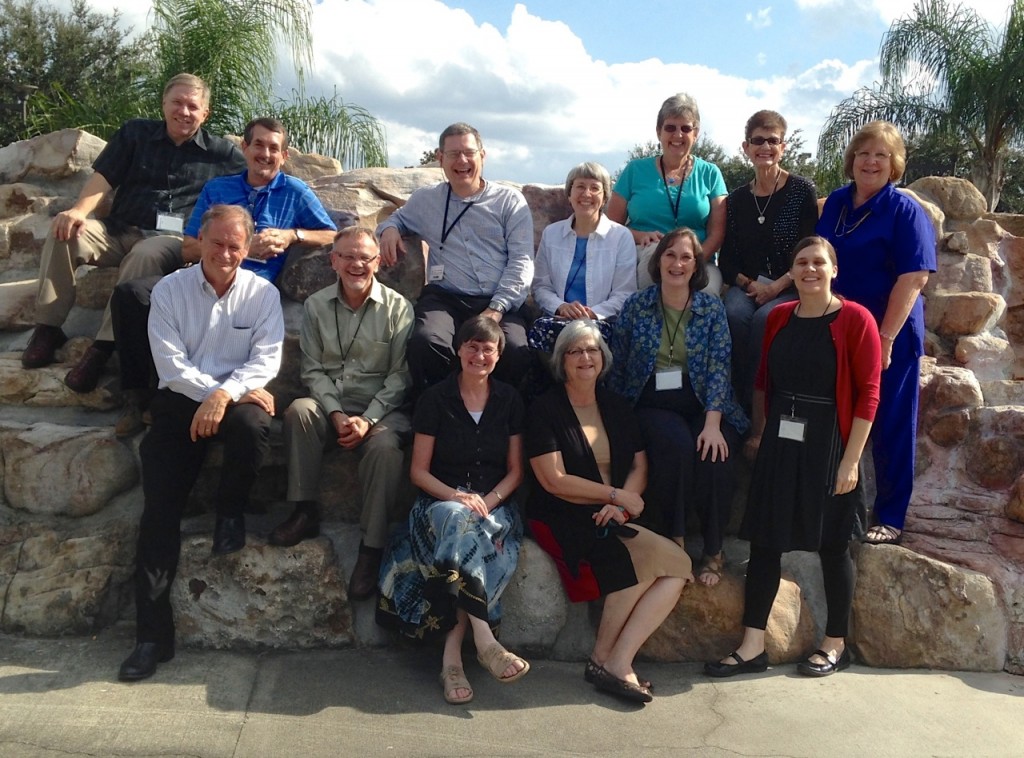 Since Sunday I have been in Orlando to attend communication meetings for SIL International. In a changing world, we are looking at how we need to update the messaging to share about the work we are doing. As the SIL Pacific Area Communications Coordinator it was really encouraging and energizing to meet with colleagues working in communications.
Since Sunday I have been in Orlando to attend communication meetings for SIL International. In a changing world, we are looking at how we need to update the messaging to share about the work we are doing. As the SIL Pacific Area Communications Coordinator it was really encouraging and energizing to meet with colleagues working in communications.
I started my trip in Dallas where I met with colleagues to discuss how we will integrate pages for the Pacific Area. After a quick trip to Detroit to see my family, I will return to Dallas for a few days before starting my journey back to the Solomon Islands on Sunday, November 10th.
Besides the planned meetings, there have been a number of unplanned meetings with colleagues that were timely and helpful.
I’m looking forward to heading home, but I’m thankful for the opportunity to be here in the USA.
Friday 11 October
The ship was scheduled to leave Honiara at 6 pm yesterday and we finally got underway about 6:45. I would definitely rate this as one of the nicer trips I’ve had by ship. The sea stayed calm, with only some gentle swells. I managed to get a few hours sleep stretched out on the wooden bench. We stopped briefly at a couple of villages before dawn and then made a more lengthy stop at Kiu village. A small, protected harbour and coral sand beach made for a nice landing area. And the Phoenix sidled up to the beach and dropped the front ramp. Passengers and cargo streamed off, to be greeted by canoes waiting for cargo and a small open-air market waiting for the passengers.
Feeling a bit hungry, I bought a foot-long skewer of roasted molluscs (think clams). Munching on these, I headed back to the ship. As I was finishing off the last few, a passenger offered me some ‘pudding’. I gladly took a slice, asking what kind it was. “Kakake pudding” was the reply. Kakake is a type of edible swamp taro, commonly used for this dish, and a favorite. There are several ways to make pudding, but one common method is to peel and boil the taro, then grate it and mix it with coconut milk that has been boiled down to a thicker cream. The mixture is then wrapped in banana leaves and baked in a ground oven. The result is a heavy, starchy cake, infused with and covered by coconut cream. Very rich, but tasty too.
Shellfish and ‘pudding’ for breakfast – ah the islands life.
Those of you who follow Martha on Facebook will know that I made a trip to one of the provinces here in the Solomons a couple of weeks ago. During that time, I was out of communications contact, except for some occasional text messages to Martha and very short phone calls.
However, I did do some blogging on that trip, which I thought I’d still share, even though it’s a bit old now. Wo, remember, I’m back in Honiara now and back in the land of electronic communications. Thanks for your prayers during my journey.
Thursday night 10 October
Well, after a long day of scurrying around I’m off to the island of Small Malaita. I’m traveling with Marion Luihenue, the Coordinator for our project, and Jonathan Soiseu, a member of the Solomon Islands Bible Translation and Literacy Partnership, and long-time Bible translation worker.
The airstrip on Small Malaita has been closed for almost 10 years because of a land dispute, so the primary way to reach the island is by ship. We are on the LC Phoenix, the nicest and most reliable ship available (ironically often called ‘Phonics” by many locals).
The ‘LC’ stands for “landing craft”; a type of ship with a flat bottom, open deck for heavy machinery and cargo, and a front drop ramp. A landing craft can sidle up to a beach or low wharf, drop its front ramp, and off load heavy equipment right to shore – essential for heavy construction or, more commonly here, logging. The Phoenix is exceptional in that it also has a large 3 deck passenger section. Perhaps it was a small ferry in its previous life – handling passengers and some of their vehicles. Today, it’s the best available transport for our trip. Fortunately, it’s not very crowded And the sea is relatively calm.